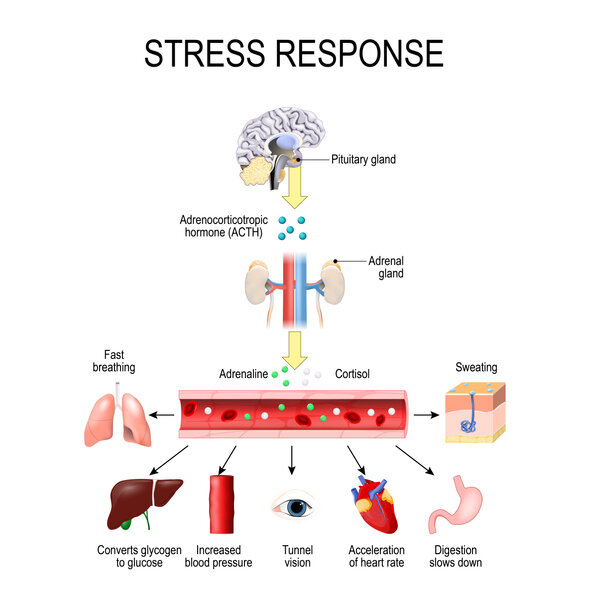Fight and Flight
Fight, Flight, Freeze is a series of responses our bodies go through when facing threat. It is a survival mechanism that uses 'low roads' in the brain so our bodies respond quickly. The limbic system (where this mechanism resides) doesn't differentiate between physical threat and psychological threat/stress. So our bodies respond to the stress of being really late to an important meeting the same way as the responses a person might have if physically attacked. This post will explore the 'Fight and Flight’ response.
Fight or Flight Response
When we’re responding to stress or danger out of the ‘fight or flight’ response our brains are using the mammalian, limbic brain. The image above shows how cortisol and adrenaline get the body ready to face threat. Our heart-rate speeds up, digestion slows down or stops, we get ‘tunnel vision’ where we fixate on the threat. There are a whole load of physiological changes that happen such as faster breathing, legs feeling restless, stomach ache - you might notice some of these when you get stressed, scared or angry.
When we start responding to threat we have a reduced capacity to empathise, recognise faces and facial expressions and rationalise. We are reacting with survival instincts rather than using social intelligence.
Often responses from this area when used to combat psychological threat may sort the situation at the time, but afterwards leave us feeling unhappy with how we have handled it. If we don't engage our ‘top brain’ to reflect on situations our responses stay the same, leading to further feelings of guilt/shame/exasperation. Contrary to popular belief, it is more likely that the same situation with occur again when we feel ashamed of our responses as we are less likely to want to reflect on it after. There are skills and techniques you can use to help aid reflection and break the cycle, and even things to do before we’ve acted to counter the threat.
One of the main ways is to start paying attention to our physiological states and challenging ourselves on whether the threat is real or imagined. For example:
You start noticing your muscles are getting tense, jaw clenching and breathing faster when you take the wrong turn when driving somewhere with your partner. You don’t know the roads and you start to worry that you’re going to be late. When operating from the fight-flight response you might chose to snap at your partner and blame them for rubbish directions. The fight response may alleviate some of the stress you’re feeling but it isn’t helpful in the long run.
By paying attention to the signs of feeling tense and breathing quicker, we can be aware of what state we might be operating in- the limbic. Then we can chose to do something to help regulate ourselves, such as deep breaths. These regulating techniques help to switch our ‘top brains’ back on so we can think more clearly. Once they’re back on we can before challenge whether the situation is actually a threat. In the above example you’d realise that it isn’t a real threat, just stressful, and find a different way of dealing with the issue.
There are plenty of ways to learn to regulate emotions and lots more ways to challenge our thought processes of what’s threatening and whats not. Counselling is a great way to aid this process as well as providing a non-judgemental space to reflect on when we have responded in ways that leave us feeling awful.
The next blog post will explore the the ‘Freeze’ response.

